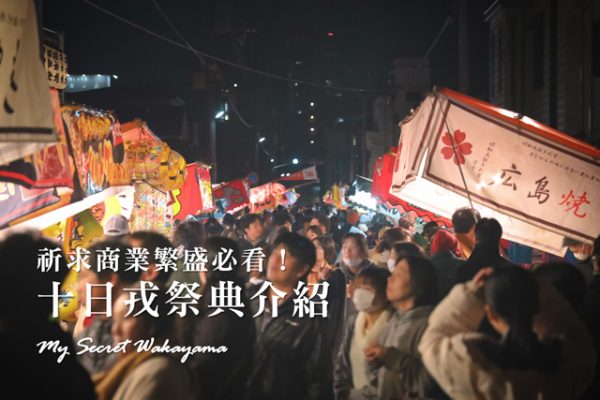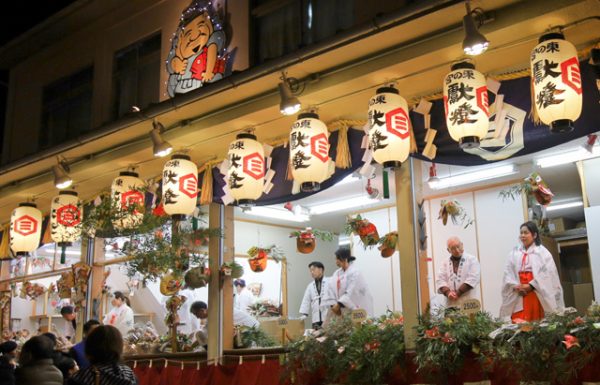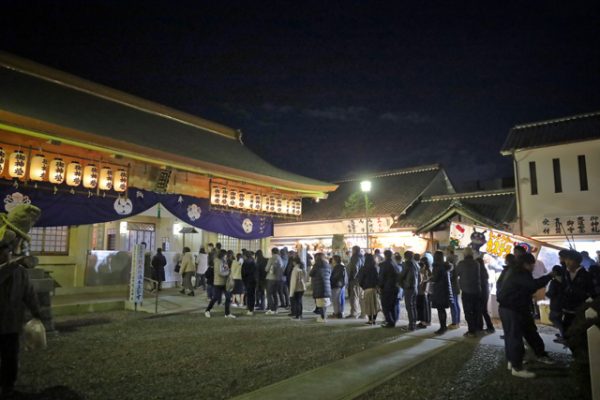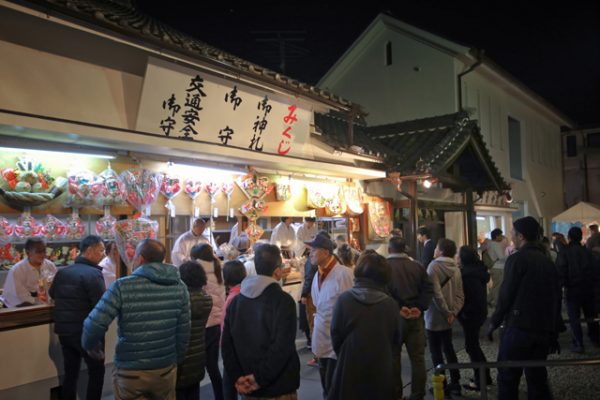Toka Ebisu
十日戎Information
- Address
-
2-1 onomachi , Wakayama City Minatofukiage-jinja Shrine 640-8224
〒640-8224 和歌山県和歌山市小野町2-1 水門吹上神社
- Access
- 10-minute walk from the NANKAI WAKAYAMASHI station
- Open Hours
- January 9 ,10,11
9:00 to 24:00 *January 11 is until 23:00.
- Phone Number
- +81-73-422-7007
“Toka Ebisu” is an event that visits “Ebisu-sama” (Ebessan), the god of business prosperity, abundance and fishing, and wishes for this year’s fortune.
January 9th is called “Yoi Ebisu”, 10th is called “Hon Ebisu”, and 11th is called “Nokori fuku”, this event is held on 3 days every year.
In the shrine, the atmosphere is very livery. Many people come to buy lucky charms and visit night shops nearby.
At Wakayama’s Tokabi Ebisu, candy called “Noshiame” is sold. It is a unique candy that is rarely found in other areas.
The pink-and-white pattern said to bring a good luck, and Minatofukiage-jinja Shrine is also known as the shrine where noshiame-candy originated.
Travel Blogger's Review

- Ryan
- He is a travel blogger who is living in Taiwan. The blog mainly shares the travel experience of Asian countries. The "homemade travel map" is the biggest feature of the blog to attract readers. The travel map has been downloaded by more than 300,000 people so far. Walking will leave "footprints", because only with your feet can you experience each story and every journey more deeply.
He've been to Wakayama City, from 8th to 10th January in 2020.
His blog is "果子的腳印 Ryan's footprint".
http://ryanyang0725.pixnet.net/blog
My earliest impressions of Japan is everyone wearing clothes with the word “祭” and dancing passionately. Most of those impressions are during the summer festival in June to September each year.
But every winter, in the cold January of Japan, in addition to the New Year, there is an important festival in Kansai that you must know is えびす!
If you travel to Japan or have a study of Japanese culture, you will know that Japan has the Seven Lucky Gods.
There are seven most important deities in the Japanese’s faith, just as Taiwan always worships certain gods. The “Seven Lucky Gods” in Japan mixed the religions from all over the world. They are mainly originating from India and Mainland China and first be established in the Muromachi period. Then prevalent in the Edo period. At present, there are seven lucky gods in various places in Japan to guard the residents of that place.
In addition to collecting the 朱印 of the Seven Lucky Gods while visiting Japan, if you put a model or picture of the ship of the Seven Lucky Gods under the pillow at 1/2 night (the next day of the new year), you can have a good dream and bring good luck for the new year.
Seven god are 七福神分別是三尊印度裔代表開運的「 大黑天」(India, represent good luck), 「 毘沙門天 」(India, represent wish come true), 「弁財天」(India, The only goddess responsible for music, art, learning and wisdom), 「福祿壽」(China, represent longevity, property and children),「 壽老人 」(China, represent longevity)「布袋尊」(China, represent good relationship between couple), and 「惠比壽」(The only Japanese deity).
Knowing the Seven Gods of Fortune in Japan, what does it have to do with 十日戎, what is “十日戎” (え び す)?
Every year from 1/9 to 1/11, a three-day “十日戎” festival is held. Since there are many shrines that worship Ebisu in the Kansai area, this festival is mainly held in Osaka Prefecture, Kyoto Prefecture, Hyogo Prefecture, Nara Prefecture, and Wakayama Prefecture. Over a million people participate every year in 十日戎. The main celebration is the only native deity of the Seven Blessed Gods, “Ebisu.”
The Ebisu God ’s Japanese is “えびす様”, which is similar to the Japanese pronunciation “Ten Days” (え び), so the date is set on the 10th day of the first month, plus the 宵祭「宵えびす(前夜惠比壽)」” and the next day’s 殘祭「残り福」 is three days in total.
Ebisu is the child of the Japanese creation gods “伊奘諾尊” and “伊奘冉尊. Ebisu were thrown into the sea before grew up, and became the god of sea and fishery after many days later. This prove the old saying in Taiwan. Ebisu holds a fishing rod in his right hand and snappers in his left, representing a thriving business and a good harvest in the fishing industry. In addition to fishery, modern people also regard it as the god of commerce, and believe that worshiping him religiously can bless business prosperity.
The important highlights of えびす
First of all, 十日戎 is the same as a normal Japanese festival. It does not require a reservation in advance, and can be attended by both Japanese and foreigners. During the period of 十日戎, there were three important points that I recommend to noticed.
緣起物「福笹」
During the festival, many Japanese people huge bamboo decoration in their hands on the road, which is called “福笹”. It is decorated with lucky symbolic items such as Ebisu God smiley face, gold coins, rice bags, fish ornaments, etc. It is said that the more accessories, more prosperous and lucky the year will be. Because the Japanese of bamboo is”ささ”, so holding the bamboo is “ささ持ってこい”. That means praying for prosperity coming soon.
The most eye-catching in the ceremony「福娘、福男」
Is anyone always curious why are the Japanese boys and girls seen in various festivals always very cute, handsome, and very kind? This is no coincidence. Each year, each shrine will hold the selection of 福娘 and 福男 3 months before the festival. It is said that the most competitive 福娘 needs to stand out from more than 3,000 unmarried beauties who are 18 to 25 years old. I f you been selected as 福娘 is a symbol of identity and will be particularly prosperous in that year. In the ceremony, if you have bought a lucky bamboo or a mascot, these 福娘 will hand them to you!
I thinks that the way of inheriting rituals in Japan is really worth learning. Let these most traditional cultures be passed on from a group of boys and girls that may be the most influential among the younger ethnic groups and continue to be carried forward.
- A lively stall selling Japanese snacks and game
The 屋台 means “roadside stalls”. During the festivals, the whole row of 屋台 can often be seen as crowded with people, because Japan does not have night markets everywhere like Taiwan. The 屋台 is also a good place for Japanese men and women to date after visiting the shrine!
after know so much about 十日戎, Where can I feel the excitement of えびす?
There are many Ebisu shrines in Japan. The most famous of them are three, namely the “西宮神社” in Nishinomiya, Hyogo Prefecture, the “今宮戎神社” in Osaka Prefecture, and the “京都ゑびす神社” in Kyoto Prefecture.
西宮神社 is the head office of the entire Ebisu Shrines in Japan. At first, Ebisu God drifted along the sea, and finally landed here and was enshrined in the 西宮神社;
I believe everyone should be familiar with the “戎橋” on 道頓堀河. It is built for the convenience of local residents and tourists to the 今宮戎神社, and it is also one of the guardian shrines to the west of 四天王寺 in Osaka. The ゑびす神社 in Kyoto is the birthplace of 福笹. And it is different from other places during 十日戎, there are five days, and 1/11 of the festival will let local 舞妓 to be 福娘 to giving the mascot.I was in Wakayama Prefecture during the ten days, so I am going to share two major shrines in Wakayama to celebrate theえびす
a.水門吹上神社
水門吹上神社 is located near the “Wakayama City” station and walks for about 8 minutes. It built in the Meiji period, then it experienced tsunami and war so move to many places, and finally reached its current position now. It is said that it is the Wakayama prefecture’s 十日戎 birthplace. At the same time, it is also the birthplace of Kishu’s unique candy 「 のし飴 」!
b.東の宮恵美須神社
東の宮恵美須神社is located near the Wakayama Station and is about a 10-minute walk. In the fall of 1951, after the end of the Second World War, the villagers who survived from the war began to rebuild their hometowns. This shrine was established in order to allow everyone to have spiritual comfort in addition to physical reorganization. At the same time, it is hoped that Wakayama can stand up again and continue to be prosperous with business, so they worship Ebisu.
Crowds of people waiting in line during the ceremony
Everyone hopes to get one 福笹 in line
Blessing ceremony in 東の宮恵美須神社
After receiving the 福笹, some people will burn it directly, and some people will bring it back and put it in front of their homes or at the front of a commercial car. They said you should buy one new 福笹 from the shrine next year if you really got good luck in last year from the former福笹.
「のし飴」which is only available in Wakayama, tastes sweet but not easy greasy. Initially, Wakayama had more than 30 factories to make のし飴. However, after the war, due to the tedious hand-made process, most manufacturers stop to produce it. So it’s getting harder to buy now.
のし飴 can be found from a basic single price of 200 yen to a bundle of thousands yen or even ten thousand yen . Some のし飴 will also add Ebisu’s smiling face, or combine 福笹 to add more blessing.
りんご飴 which is my particularly likes in the festival. Compared to Taiwan’s string of tomatoes or strawberries, Japan’s style is to wrap the whole apple with syrup directly.
It is said that this kind of old stall that looks a little dirty is actually the best food!
Fish and ball games often seen in Japanese TV series
During the festival, if you buy the 福笹, you can also get a raffle ticket to play the “blessing machine”「福引機」
The prize can win travel coupons, bicycles, and other prizes! It ’s so amazing that even the prizes are very Japanese style.
Alright! The next time when you arrange a winter vacation, you can check whether the journey time will cover the “十日戎”. If so, you should pray for the prosperity of business for the new year when you travel.
【日本|和歌山】去日本就是要玩祭典!祈求商業繁盛的「十日戎」(えびす) – 和歌山兩大主要神社活動介紹 #My Secret Wakayama
©︎ryan’s footprint果子的腳印

















